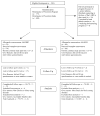Can we reduce eating disorder risk factors in female college athletes? A randomized exploratory investigation of two peer-led interventions
- PMID: 22019502
- PMCID: PMC3246101
- DOI: 10.1016/j.bodyim.2011.09.005
Can we reduce eating disorder risk factors in female college athletes? A randomized exploratory investigation of two peer-led interventions
Abstract
Female athletes are at least as at risk as other women for eating disorders (EDs) and at risk for the female athlete triad (i.e., inadequate energy availability, menstrual disorders, and osteoporosis). This study investigated whether two evidence-based programs appear promising for future study if modified to address the unique needs of female athletes. Athletes were randomly assigned to athlete-modified dissonance prevention or healthy weight intervention (AM-HWI). ED risk factors were assessed pre/post-treatment, and 6-week and 1-year follow-up. Results (analyzed sample, N=157) indicated that both interventions reduced thin-ideal internalization, dietary restraint, bulimic pathology, shape and weight concern, and negative affect at 6 weeks, and bulimic pathology, shape concern, and negative affect at 1 year. Unexpectedly we observed an increase in students spontaneously seeking medical consultation for the triad. Qualitative results suggested that AM-HWI may be more preferred by athletes.
Copyright © 2011 Elsevier Ltd. All rights reserved.
Figures
References
-
- Abood DA, Black DR. Health education prevention for eating disorders among college female athletes. American Journal of Health Behavior. 2000;24:209–219.
-
- Becker CB, Bull S, Schaumberg K, Cauble A, Franco A. Effectiveness of peer- led eating disorders prevention: A replication trial. Journal of Consulting and Clinical Psychology. 2008;76:347–354. - PubMed
-
- Becker CB, Smith LM, Ciao AC. Peer-facilitated eating disorder prevention: A randomized effectiveness trial of cognitive dissonance and media advocacy. Journal of Counseling Psychology. 2006;53:550–555.
-
- Becker CB, Wilson C, Williams A, Kelly M, McDaniel L, Elmquist J. Peer- facilitated cognitive dissonance versus healthy weight eating disorders prevention: A randomized comparison. Body Image. 2010;7:280–288. - PubMed
Publication types
MeSH terms
Grants and funding
LinkOut - more resources
Full Text Sources
Medical


